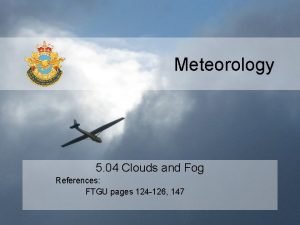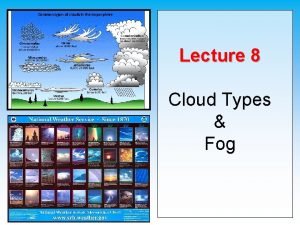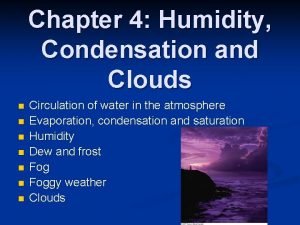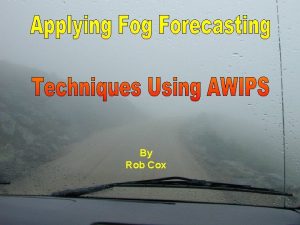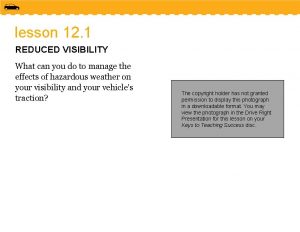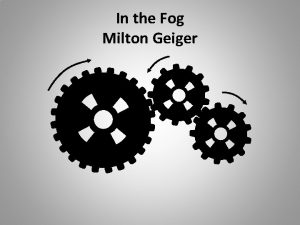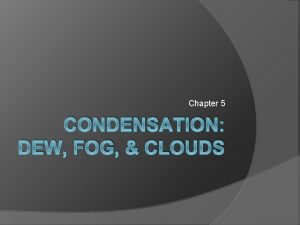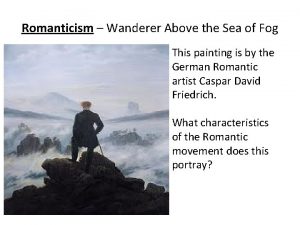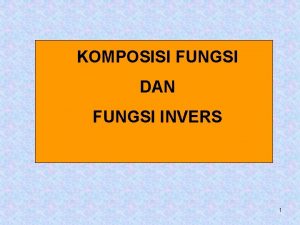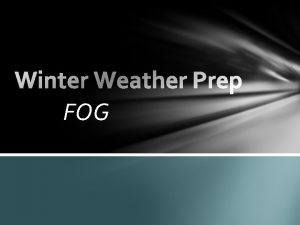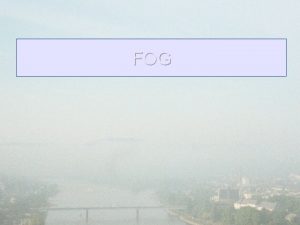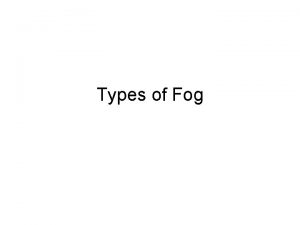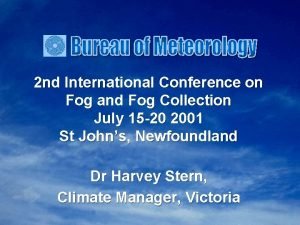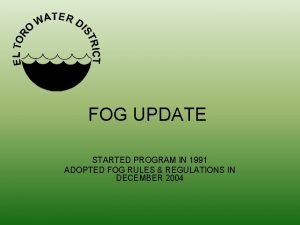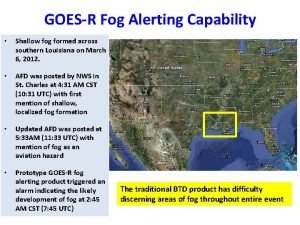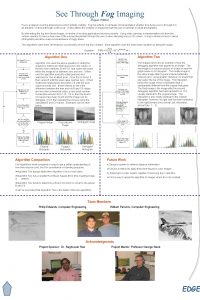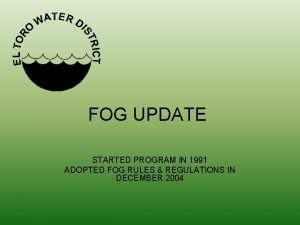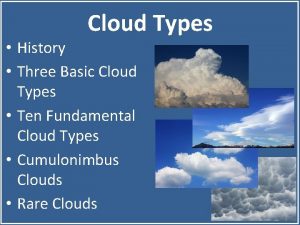Lecture 8 Cloud Types Fog What is a






























- Slides: 30

Lecture 8 Cloud Types & Fog

What is a cloud? ? ? • A cloud can be defined as any visible aggregate of tiny droplets of water or tiny ice crystals, or a mixture of both –They help meteorologists figure out what’s going on in the atmosphere

Cloud Droplet Formation Cloud Drop (10 um) Updraft (~1 -10 m/s) Cloud Base, Lifted Condensation Level (LCL)

Recipe for a Cloud 1. Cloud Condensation Nuclei (CCN) CCN – Serve as the surface for water vapor to condense upon 2. Rising Air – By one of the methods described before. – Causes adiabatic cooling – Condensation occurs at the LCL 3. Water Vapor

Why do you need CCN? • The best particles are hygroscopic (water-seeking/liking) particles – Sea salt is a good example. • Hydrophobic Particles (water repelling) can still serve as nuclei when RH is > or = 100%. • Without CCN the RH would have to be much greater than 100% for a cloud drop to form.

Why are cloud drops so TINY? ! • at first the drops grow really FAST • But…. Lots of other aerosol WANT water too… • So the water vapor is split up over a lot of little drops instead of a few big ones.

Why are cloud drops so TINY? ! Available Water Vapor 5 CCN Available Water Vapor 20 CCN

Why are cloud drops so TINY? ! Available Water Vapor 20 CCN 5 CCN Big Cloud Drops Small Cloud Drops

Cloud Classification 4) VERTICAL 1) HIGH CLOUDS 2) MIDDLE CLOUDS 3) LOW CLOUDS

High Clouds • Cirrus – Fibrous, “mare’s tails” • Cirrostratus – White, produces halo – Approach of warm front • Cirrocumulus – White, small cells or ripple – looks like “Fish Scales” • Above 6000 m (20, 000 ft) • ICE ONLY • No Significant Precipitation


Middle Clouds • Altocumulus – Large patches of rounded masses or rolls – Usually water droplets • Altostratus – Formless layer of grey cloud cover – Sun is only visible as a bright spot. – NO Halos JPL – Pasadena, CA • Between 2000 -6000 m (6, 500 -20, 000 ft) • Mostly Water • Infrequently Precipitates Snow or Drizzle Beach in Long Island, NY

Low Clouds • Stratus – Uniform layer covering most of sky – Sometimes precipitation • Stratocumulus – Scalloped bottom, covering most of sky – Long parallel rolled or blobs • Nimbostratus – Chief precipitation producers (light but for a long time) – Associated with Stable conditions • Below 2, 000 m (6, 500 ft) • LIQUID ONLY

Clouds of Vertical Development • Cumulus – Individual masses that develop into vertical domes or towers – Tops often resemble cauliflower – Form on clear days • Cumulonimbus – When Cumulus grow out of control – Dark, dense, billowing clouds – VERY TALL 12 -20 km (7 -12 miles) • Bases are low (below 2, 000 m) Tops up to 20 km!! • Water at the base, can have ice if they grow tall enough (into cold air) • Related to unstable air

Photo Credit: Travis Marcombe

Cloud Varieties – Additional Terms • Mammatus – Looks like udders – Happen after/before severe weather or Thunderstorms • Lenticular – Looks like lentils or lenses – Most often seen near mountains


Cloud Type Summary Table Cloud Family & Height Cloud Type (abbreviation) High Cirrus (Ci) Info Thin delicate filaments, ICE crystals, wispy Above 6000 m Cirrostratus (Cs) Cirrocumulus (Cc) Middle Altocumulus (Ac) Thin white sheet, ICE crystals, produce halos around sun and moon Thin white, ICE crystals, and look like fish scales White to grey, blob like… though widespread Between 2000 -6000 m Altostratus (As) Low Stratus (St) Thin veil of clouds, may see sun as a disc but no halos Low uniform layer, like fog, may produce drizzle Below 2000 m Vertically Developed Stratocumulus (Sc) Soft, grey clouds, blobs and batches or rolls. Nimbostratus (Ns) Dark grey formless clouds, RAIN producers Cumulus (Cu) Cumulonimbus (Cb) Have flat bottoms, fair weather, billowy, cauliflower tops Towering clouds, sometimes form anvil heads, Heavy rainfall, hail, lightning, thunder and tornadoes

NAME THAT CLOUD Lenticular Cirrus Stratocumulus Cumulus

Types of Fog • FOG = a cloud with its base at or very near the ground. • Fogs formed by Cooling – Radiation Fog – Advection Fog – Upslope Fog • Fogs formed by Evaporation – Steam Fog – Frontal Fog


Fogs Formed by Cooling • Radiation Fog – The ground cools the air close to the surface – A night time phenomenon – Clear Skies – Fairly high RH – Cold air sinks in valleys – Dissipate after sunrise


Fogs Formed by Cooling • Advection Fog – Warm moist air is blowing over a cold surface – Advection = horizontal movement – Turbulence (wind) is needed to make it thick


Fogs Formed by Cooling • Upslope Fog – Humid air moves up a gradual sloping plain or mountain • As it moves up it cools… if to dew point you get fog – Ex: Great Plains • Moist air from Gulf moves up towards the Rockies


Fogs Formed by Evaporation • Steam Fog – Cool air moves over warm water – Rising air cools and condenses – Moister added into the layer!!!!


Fogs Formed by Evaporation • Frontal Fog – After warm air is pushed upward – If cold air is near dew -point rain can evaporate and then produce fog – Results from the addition of water vapor into a cool layer of air
 5 types of fog
5 types of fog Fog is a type of this cloud
Fog is a type of this cloud Advection fog vs radiation fog
Advection fog vs radiation fog 01:640:244 lecture notes - lecture 15: plat, idah, farad
01:640:244 lecture notes - lecture 15: plat, idah, farad Wfo cox
Wfo cox Cloud computing cmu
Cloud computing cmu Cloud computing lecture
Cloud computing lecture Cloud computing refers to
Cloud computing refers to Cloud to cloud integration patterns
Cloud to cloud integration patterns Public cloud vs private cloud cost analysis
Public cloud vs private cloud cost analysis Lepsnap
Lepsnap Les objectifs de la lecture au primaire
Les objectifs de la lecture au primaire Hamza kashgari
Hamza kashgari V-fog svets
V-fog svets Optical density of gross fog
Optical density of gross fog Personification about arms
Personification about arms Anger fog
Anger fog Sky fog ogre
Sky fog ogre Dirty headlights can reduce visibility up
Dirty headlights can reduce visibility up In the fog by milton geiger summary
In the fog by milton geiger summary What does skid mean in driving
What does skid mean in driving Light fog artifact
Light fog artifact Stratus clouds
Stratus clouds Wanderer above the sea of fog caspar david friedrich
Wanderer above the sea of fog caspar david friedrich Vray brdf
Vray brdf Grease interceptor
Grease interceptor Wanderer above the sea of fog sublime
Wanderer above the sea of fog sublime Noise texture css
Noise texture css Difference between dew and frost
Difference between dew and frost Fog invers
Fog invers Clouds, fog, or dew will always form when
Clouds, fog, or dew will always form when
